|

Sengkang station
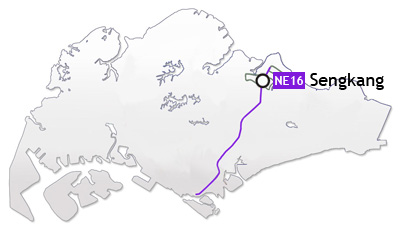
Sengkang station is the
gateway to Sengkang New Town. Meaning "prosperous harbour"
in Mandarin, Sengkang station showcases Singapore's success
in integrated
town and transport planning.
The station is fully
integrated not only with other transport facilities, such as
the bus interchange and the Sengkang Light Rapid Transit
(LRT) system, but also with
residential and commercial developments, like Compass Point
and Compass Heights. The efficient utilisation of land space
is exemplified by the sitting of two tennis
courts above the LRT station.
As an interchange station,
commuters from the North East Line in the basement can
transfer to Sengkang LRT station by escalators and
lifts
without passing through
the fare gates. Commuters coming from Compass Point at the
mezzanine level can head straight to the LRT platform on the
third level or go down towards the
concourse to catch trains running along the North East Line.
Back To Top
Glass art has been
described as "painting with light", and with good reason.
For it is the play of light, in its many moods, on glass,
that makes a stained glass work
come alive and subtly evolve through the course of a day.
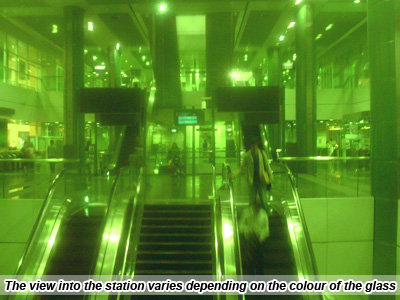
At Sengkang station, Koh
Bee Liang branches out from ecclesiastical commissions to
find her voice in contemporary glass art for a public space.
Her work is vibrant
and colourful yet quiet and dignified; gently inviting
commuters to pause and take in the beauty of traditional
glass as they hurry through the station.
The artist's works
comprise two stained glass murals depicting life in Sengkang
today and in the past. The murals are located above ground
at opposite ends of the
station concourse. Near the escalators, the artist uses
semi-abstract images of rural scenes to depict life in old
Sengkang. At the opposite end of the station near the
staircase, new Sengkang is represented by abstract images of
the skyscrapers that are now part of the area's landscape.
Back To Top
These images of new
Sengkang were created using a mixture of highly transparent,
mouth-blown, textured and opalised glass accented by
colours, bevel strips and
lenses.
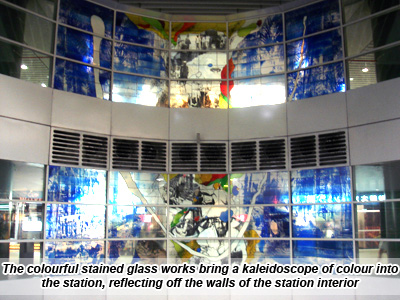
The artist's sentiments
are echoed by a poem accompanying the artworks. Composed by
poet Lee Tzu Pheng, the handwritten verse gives commuters
something to
ponder while the painting makes its impact.
According to the poet, the
text captures human aspirations on two levels - expressed as
urban development and as a longing for the fulfilment that
spiritual life can
bring.
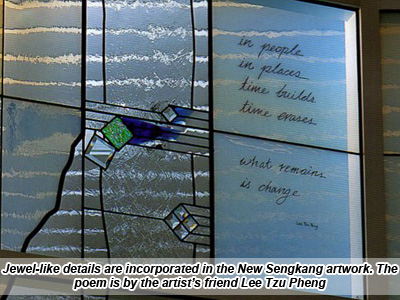
Back To Top
Going beyond merely
depicting high-rise HDB (Housing Development Board) blocks,
the artist has also incorporated an element of commentary
into her
works.
Demonstrating how urban
renewal in Singapore often means having to part with an old
home and the memories associated with it, the artist
incorporated a drawing
of a building being demolished into her works.
Using glass as her canvas
as well as her paintbrush, the artist had cleverly chosen
the types and cuts of glass with care to create interest and
variation in her work.
Bevels or glass with shape angled cuts are used to catch the
light, drawing the eye to the work. At the same time, the
smooth 'blank' spaces in the work add
breathing space and different textures to the whole.
In contrast to the
simplicity of the new Sengkang mural, the artist's
perspective on Sengkang's part is more involved. Assorted
characters from Singapore's recent
past find their way into the work - there are village women
and their children, British colonials, a Malay fisherman and
an Indian curry paste seller. Drawing all these
elements together is the image of a village well rendered in
a single, bold brushstroke. According to the artist, the
well represents a source of life that also serves as
a gathering place for village folk.
Back To Top
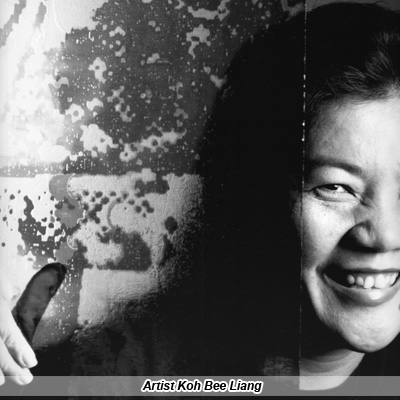
The artist uses different
types of glass for the murals of old Sengkang, working with
opalescent glass, which has a softer, more dewy feel in the
middle of the work,
and transparent glass at the sides. The glass was also
treated in various ways, some pieces were silk-screened and
fired while others were airbrushed and fired. But
it was the process of etching large pieces of glass that
stretched the artist the most.
One of the more
interesting effects created by etching is something that
looks like a thin veil of water running through the centre
of the images on opalescent glass.
It is almost like a veil of tears, perhaps of joy, perhaps
of sadness, through which we look at the past.
Artist:
Koh Bee Liang
Born: Singapore, 1960
Education:
- Painting workshop with British painter Patrick Renytiens,
1989
- Glass casting workshop by American hot glass artist Dan
Fenton, 1990
- Worked as stained glass designer and ecclesiastical
stained glass painter
in North America, 1989 - 1992
- Hands-on workshop with Lutz Haufschild, 1995
Derrixglassstudio, Taunaustein, Germany
next: Punggol station
Back To Top
|